The
Rouge National Urban Park Pilot Sampling

In
collaboration with Parks Canada, VSP pilot sampling in the
Park was conducted in 2015 by two
Master
of Forest Conservation students:
Suzanne Perry
and Emma
Bowley. This project enables
information about vegetation communities throughout the park to be
collected, exploring its applications to vegetation management and
comprehensive
vegetation monitoring. The modular nature of VSP is adaptable to a wide
range of vegetation communities and management objectives, and as such
enabled a multitude of vegetation and habitat measures
to be collected in 2015. Sampling was also conducted during summer 2016.
City of Kitchener: Natural Areas
Inventory and Monitoring
The
City of
Kitchener maintains a total of 169 natural areas comprising
of
wetlands, woodlands,
meadows, and waterways. This amalgamation of natural areas possess
significant wildlife habitat and landforms that are recognized for
their ecological value. Due to severe urban pressures such as
development, invasive plant
and insect outbreaks, pollution, and recreation occurring in these
urban forests, it has become important to monitor the effects that
these threats are having on the City’s remaining forest communities.

VSP was first undertaken in Kitchener in the summer of 2015. In
collaboration with the
Faculty of Forestry, University of Toronto
and the
Ontario Ministry of Natural Resources and
Forestry, the City of Kitchener aims to utilize VSP’s diverse
information on
the composition and structure of its vegetation communities to
improve their future management, land-use planning, and conservation
actions.
The 2015-16 field
sampling enabled the collection of vegetation information throughout a
number of parks and natural areas, as well as setting the stage
for comprehensive monitoring of natural areas within
the
City.
This
research will provide valuable information to aid in the
restoration of woodlands, wetlands and waterways that are being
threatened by their urban surroundings. With the assistance of
three MFC interns, the City has collected data on 16
of its
natural areas. Field sampling in 2015 conducted by
Master
of Forest Conservation (MFC)
students: Emma Thurston, Tania Ramkumar. Field sampling in
2016 was led and managed by Tania Ramkumar with
assistance from a
MFC
intern Joe Scott.
City of Guelph: Natural
Areas Monitoring & Emerald Ash Borer Impact on Ash
Population in
Natural Areas.
VSP sampling was implemented in Guelph in summer 2016 as a
proactive response to monitoring natural areas and assessing the
impacts and risks
on natural areas due to
Emerald Ash Borer (EAB) (
Agrilus planipennis).
Forest monitoring, as a collaborative effort among
the
City
of Guelph,
OMNRF
and
University
of Toronto Faculty of Forestry, is envisioned to provide data
that supports
research but also informs landscape planning, forest management
activities, invasive
species management, restoration efforts, protection and recovery of
species at
risk and their habitats.
Native Ash trees, found in a wide variety of forest and
habitat types, are vital to Guelph’s natural areas and urban forests.
Thus VSP
sampling 2016 targeted stands with a significant component of Ash. The
sampling
has provided critical, baseline information to quantify the existing
and
potential loss of Ash associated with EAB. In addition, data collected
enabled the
impact of Ash loss on forest composition, structure and function to be
assessed.
EAB, a wood boring beetle, was first detected in Guelph in 2011 and has
since
affected most if not all of the region’s Ash trees.
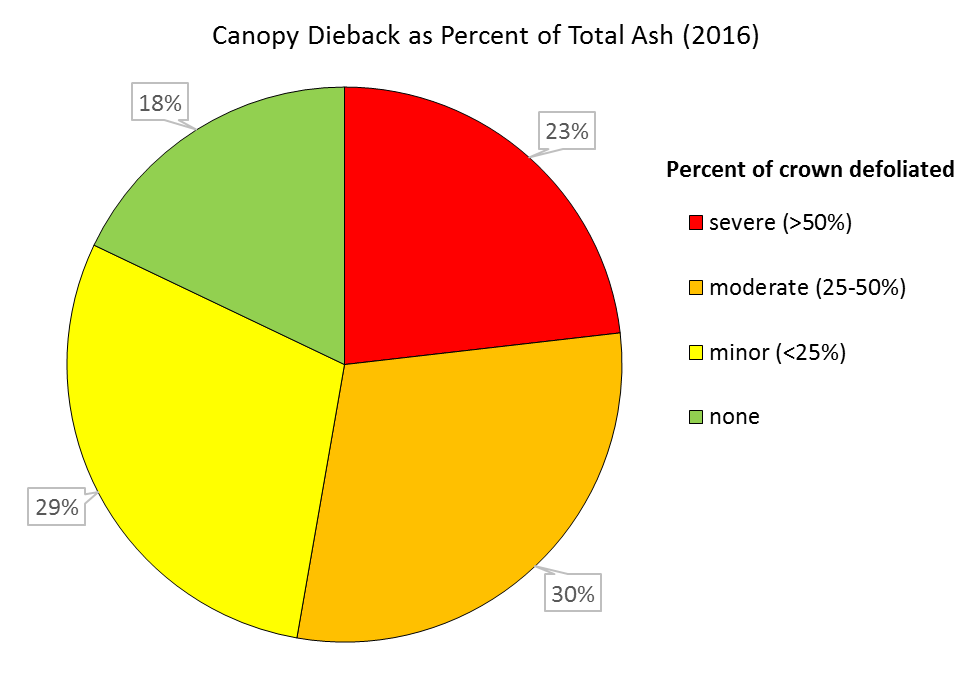
VSP sampling found Ash at 83.5% of sampled plots, often
comprising a significant component of the total tree count, relative
abundance,
biomass, and canopy cover. Based on the canopy decline assessment it
was found
that EAB already affects about 82% of Ash trees. Decline and loss of
Ash is therefore
expected to have a significant and lasting impact on Guelph’s
woodlands. These
effects include changes in species composition, loss of native species
diversity, colonization by invasive species, inhibition of forest
regeneration,
increased erosion, sedimentation and stream warming, and reduced carbon
sequestration. With the help of VSP data, high risk areas are
identified and
can be used to inform Guelph’s EAB and Forest Management Plans, aimed
to mitigate
EAB and other environmental and ecological impacts.
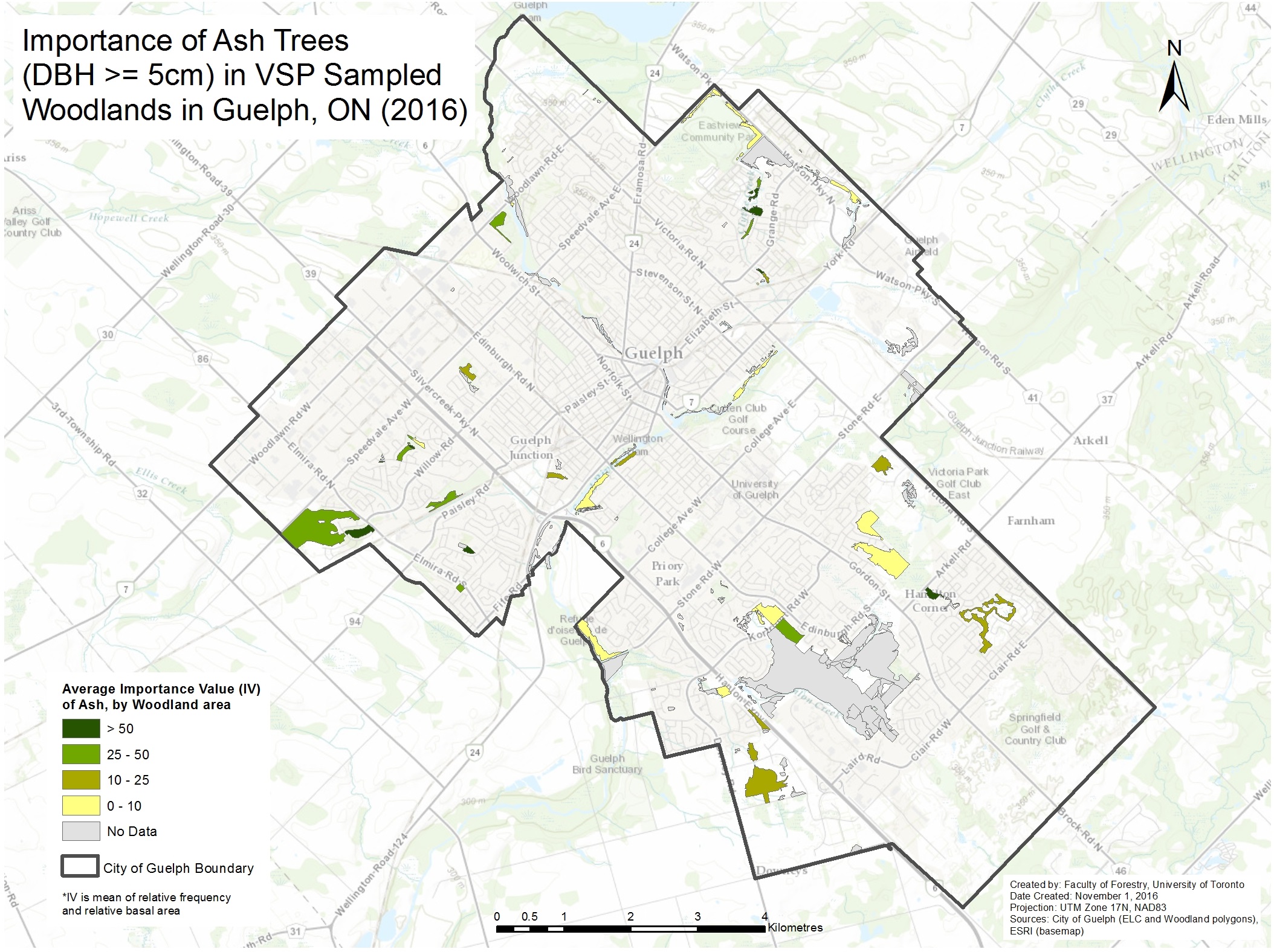
Ash Importance Value (IV) is
a measure of the dominance of Ash per Woodland. IV considers a given
woody species’ relative frequency and relative basal area within a
plot. (Click for enlarged map).
- Guelph Natural Areas Monitoring project poster HERE
- A link to the full Guelph Natural Areas Monitoring Report can be HERE
Nature
Conservancy of
Canada
Eastern Ontario
The
Nature Conservancy of Canada (NCC) completes
vegetation community
inventory and classification using VSP on their portfolio of
conserved spaces in eastern Ontario. This is part of the
baseline
inventory NCC carries out on new acquisitions. Once
vegetation
communities are classified, NCC uses this information to prepare a
property management plan and recommend a suite of stewardship
actions. One of the main applications of the classification
is in
the management of invasive species.
Ontario Nature Natural
Cover Monitoring
Ontario
Nature protects wild species and wild spaces through
cons
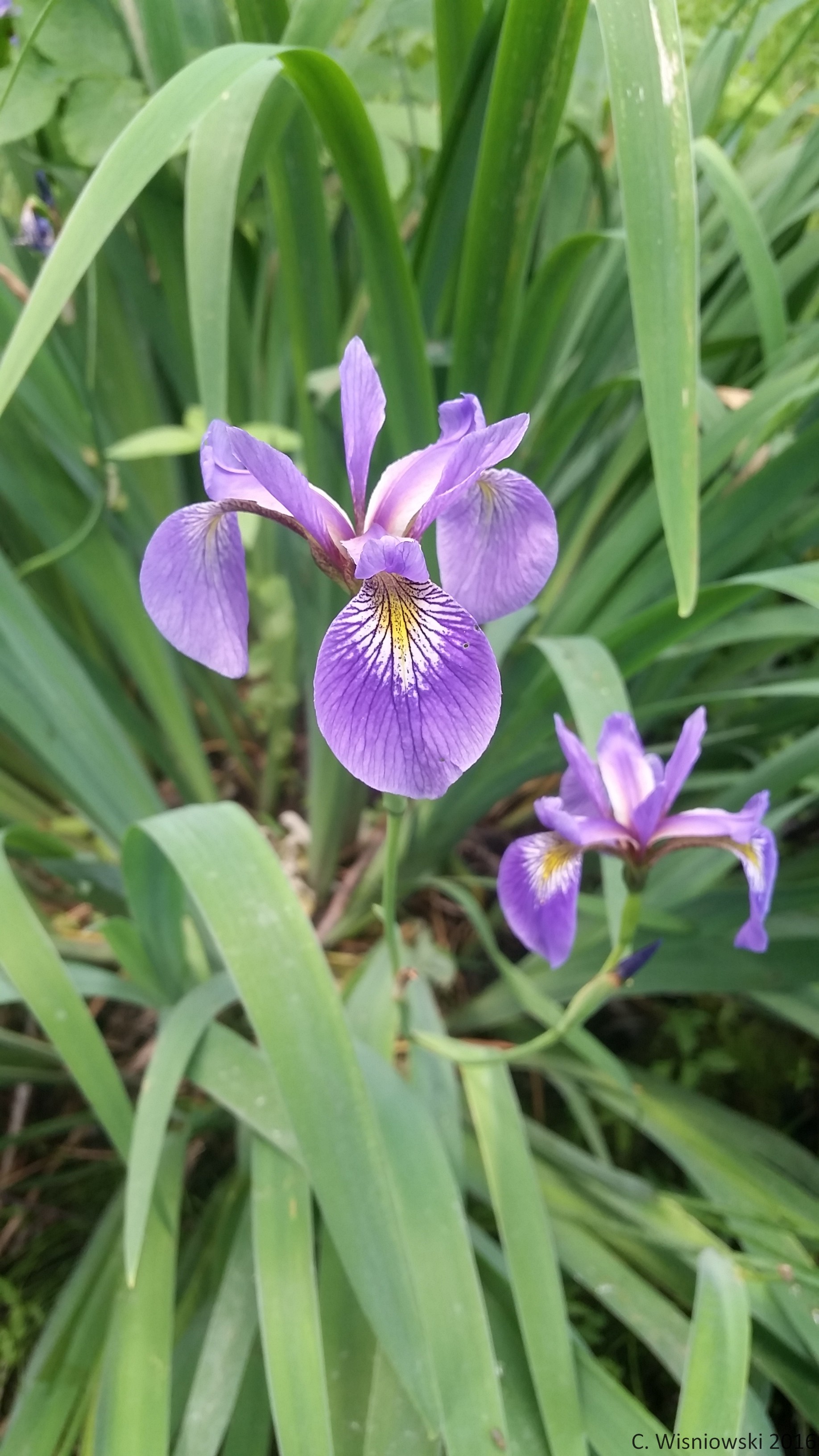
ervation,
education and public engagement. Ontario Nature is a
charitable organization representing more than 30,000 members and
supporters, and 150 member groups from across Ontario.
Ontario Nature has been protecting significant natural areas with its
nature reserve system founded in 1961, preserving some of the
province’s best remaining examples of imperiled and vulnerable
habitats. Today, with 24 properties totalling 2,788 hectares, Ontario
Nature is committed to protecting wild species and wild spaces through
conservation, education and engagement.
Ontario Nature uses Vegetation Sampling Protocol (VSP) to collect
detailed information about key habitat features on each nature reserve
to help to inform management practices and long-term monitoring goals.
More information about Ontario Nature’s nature reserves can be found
here
Ontario Nature Citizen
Science Initiatives:
Ontario Nature’s largest citizen science project is the
Ontario Reptile
and Amphibian Atlas (ORAA). Led by Ontario Nature since 2009,
the goal
of the ORAA is to improve our knowledge of the distribution and
abundance of Ontario’s reptiles and amphibians by engaging the public
in reporting their sightings. Participants can also contribute by
participating in annual monitoring programs, such as the Backyard Frog
and Salamander Surveys as well as Vernal Pool Mapping.
In 2016, Ontario Nature launched the
Directory
of Ontario Citizen
Science (DOCS). DOCS is an online platform
that connects seasoned and aspiring citizen scientists with volunteer
opportunities across the province. This tool creates a centralized
location where people can access information about citizen science
programs across the province.
VSP monitoring pilot on
the Niagara Escarpment
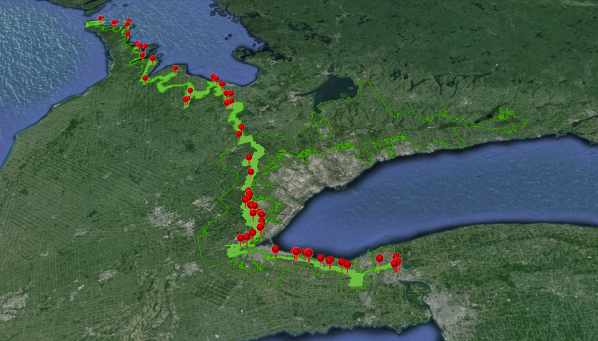
VSP
sampling was piloted on the Niagara Escarpment in 2011 and
2012.
As a result, over 130 plots were sampled across mature
forest stands previously sampled by Steve Varga (OMNRF) 30
years
ago. VSP plots were piloted to test monitoring applications
and a
comprehensive vegetation inventory, as well as to support
the diverse management, planning, and
conservation needs on
the escarpment.
This research project is a collaborative
effort between the
Faculty of Forestry, University of Toronto,
OMNRF -
Science & Research Branch (Started with the former OMNR -
Southern
Science & Information Section), and the
Niagara Escarpment Commision
& Niagara Biosphere Reserve.
VSP
sampling on Georgina Islands
VSP sampling on Georgina Island was a partnership project among
the
Georgina
Island First Nation,
the
Lake
Simcoe Region Conservation Authority, the
Faculty
of Forestry, University of Toronto, and the
Ontario
Ministry of Natural
Resources (Science and Research
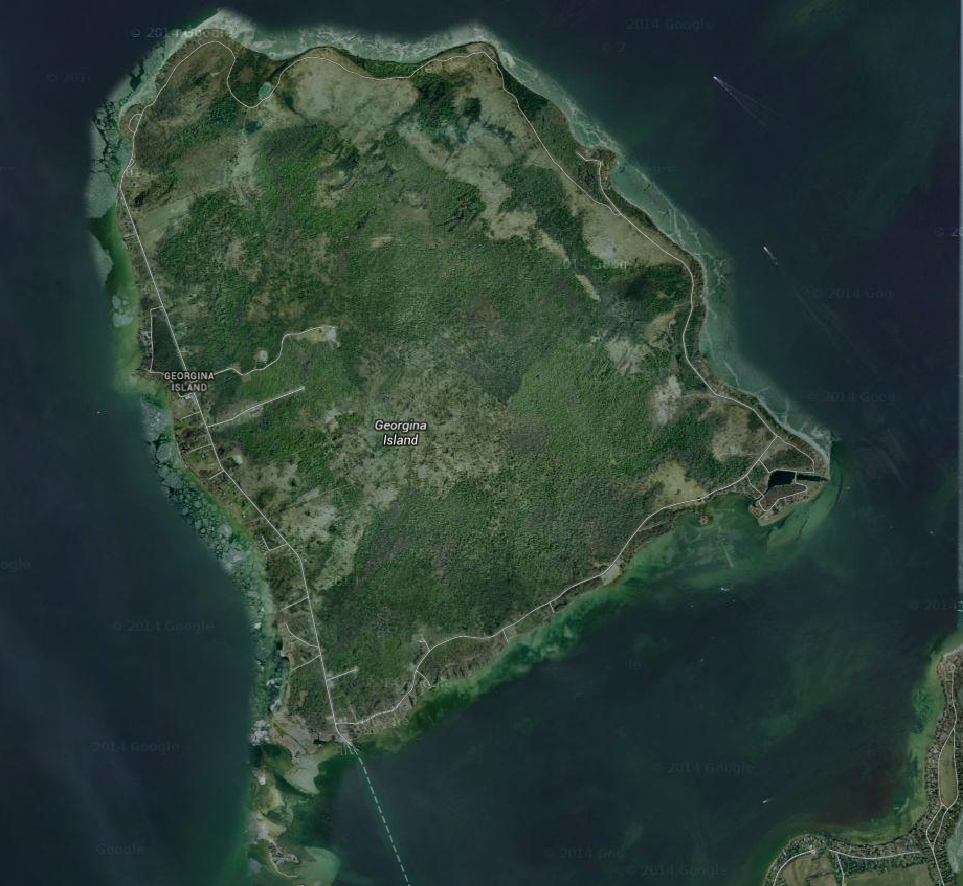
Branch,
and Southern Region - Aurora and Midhurst
Offices). A set of VSP
plots were sampled on
Georgina Island during the summer of 2014. Field data was collected
between July and August
2014 by a University of Toronto Masters student
(Gilles Pansin) and a
Georgina
Island First Nation summer student (Stephen Porte). A subset of VSP
plots was
selected from a sampling VSP grid that covered the Lake Simcoe
watershed and Georgina
Island. The VSP field data was tested for its diverse applications
to:
subwatershed planning, monitoring and planning for climate change and
adaptation, natural cover monitoring as part of the Lake Simcoe
Protection Plan,
science and research, quantitatively characterizing vegetation
communities on
the islands, quantitatively describing wildlife and species at risk
habitats, and
establishing a baseline condition for long-term monitoring.
University of
Waterloo Co-operative Education
Program
2014, 2015 and 2016
Summer 2014
Three
groups of students carried out VSP field sampling in natural areas near
Huntsville, Ontario between July and August 2014 as part of a four week
long
field course, ERS 341 and their summer Co-op program. The
summer
Co-op program provides students the unique opportunity to lead and
complete real projects for community organizations while honing their
skills as field ecologists. The
University of Waterloo provides
students with VSP training through the
Waterloo Summit Centre for the
Environment in Huntsville (also open to the public). Through
this field training and Co-op program, students gain knowledge about
how to conduct vegetation inventory and monitoring of settled
landscapes, while collecting the field information and supporting
VSP projects.
Group
1: Justin
Maddalena, Cheryl
Reyes and Timmy Nassar used the
VSP methodology to survey the
Dyer 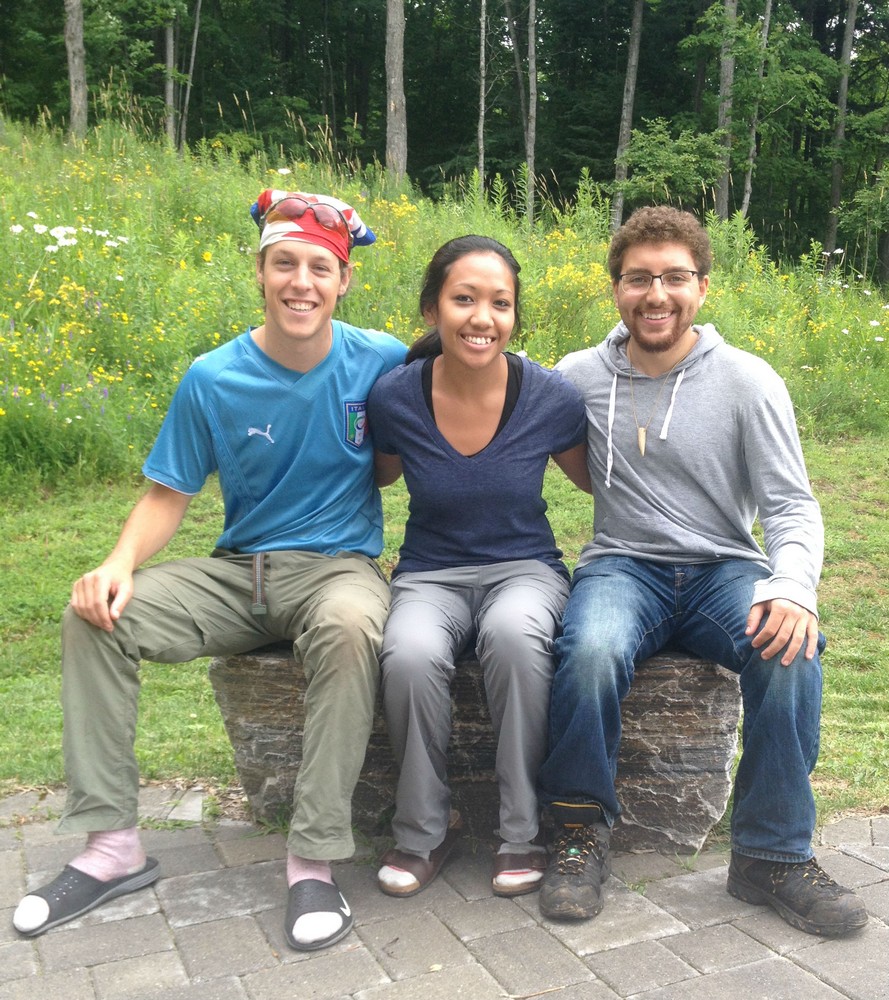 Memorial Nature
Reserve and Monument Site
Memorial Nature
Reserve and Monument Site in Huntsville,
Ontario. This
site serves as an inactive cemetery and recreational area for
the town of
Huntsville under the
ownership of the Muskoka Conservancy. The reserve
encompasses approximately
3 kilometres of
the Big
East River shoreline, a mix of deciduous andvspsupports.html
coniferous forests, and
an oxbow pond that provides
habitat for
amphibians and other wetland plants and animals. The property has been
certified as
“Ecologically
Sensitive” and property management focuses on conservation
and
landscape management with the help of volunteers to help
protect
and build heritage for future generations.
Group 2: Kyle Wang and Angela Zhou used the VSP
methodology
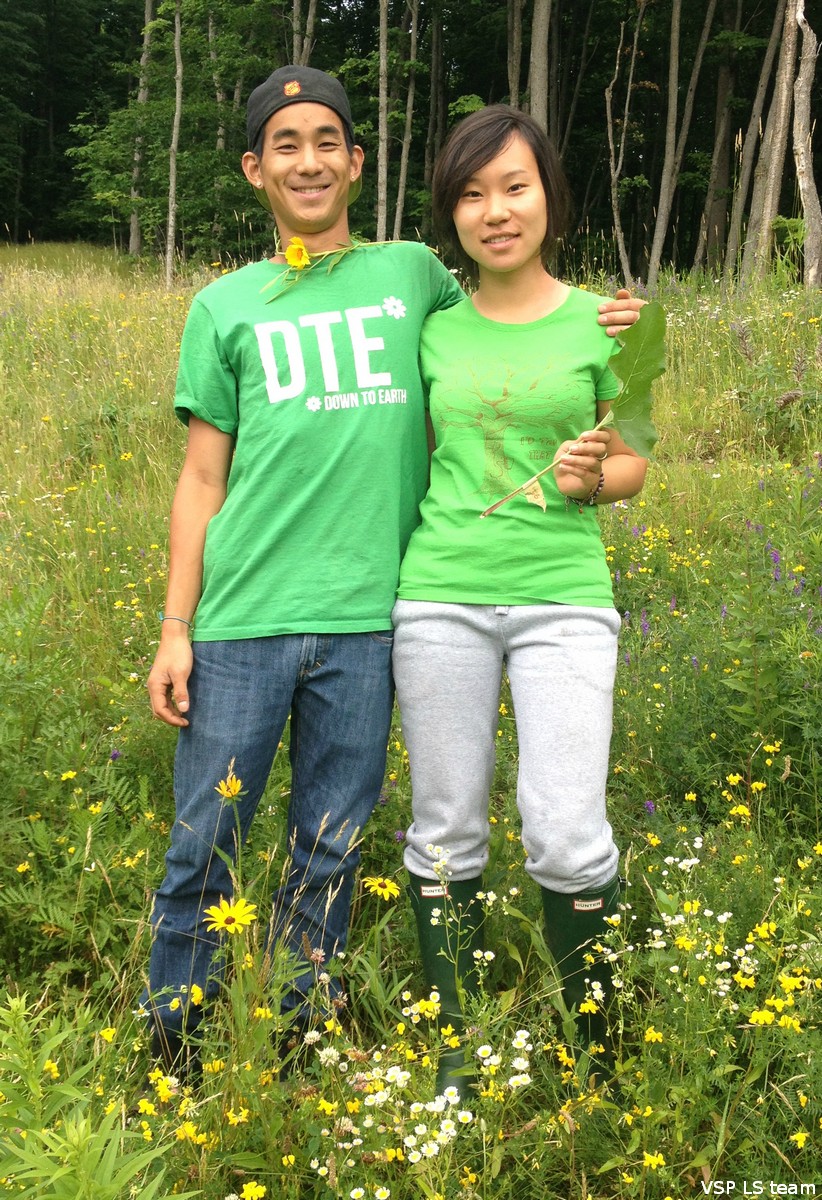
to
survey
the
Nelson Head Nature Reserve in
Huntsville, Ontario. This 9 acre nature reserve,
owned by the Muskoka Conservancy, has gently rolling terrain with
mature trees, a stream and exposed bedrock. The
nature reserve is in an urban area
surrounded by residential development and supports several vegetation
communities including forest areas with a mix of tolerant and
mid-tolerant trees, an herbaceous open area (an old homestead
site) and recently planted sites which contain young tree species. The
property also contains a fern grotto and Marsh Marigold at its northern
limit.

Group
3: Ian Blainey, Carly
Van Daele, Cassandra Weins and Jessica Williamson carried out VSP
sampling on a 1000 acre private property on Pond Meadows Road, just off
of Brunel Road, in Huntsville, Ontario.
The forest on this property is characterized by a mix of deciduous and
coniferous trees on the Precambrian Shield, including sugar maple, red
maple, black cherry, yellow birch, basswood, balsam fir and white pine.
The site also contains some lake ecosystems and trails. There are sandy
soils on the property which is typical of the area where soils are
unproductive and have low buffering capacity and lay on top of various
gneisses.






 ervation,
education and public engagement. Ontario Nature is a
charitable organization representing more than 30,000 members and
supporters, and 150 member groups from across Ontario.
ervation,
education and public engagement. Ontario Nature is a
charitable organization representing more than 30,000 members and
supporters, and 150 member groups from across Ontario.  VSP
sampling was piloted on the Niagara Escarpment in 2011 and
2012.
As a result, over 130 plots were sampled across mature
forest stands previously sampled by Steve Varga (OMNRF) 30
years
ago. VSP plots were piloted to test monitoring applications
and a
comprehensive vegetation inventory, as well as to support
the diverse management, planning, and
conservation needs on
the escarpment.
VSP
sampling was piloted on the Niagara Escarpment in 2011 and
2012.
As a result, over 130 plots were sampled across mature
forest stands previously sampled by Steve Varga (OMNRF) 30
years
ago. VSP plots were piloted to test monitoring applications
and a
comprehensive vegetation inventory, as well as to support
the diverse management, planning, and
conservation needs on
the escarpment. Branch,
and Southern Region - Aurora and Midhurst
Offices). A set of VSP
plots were sampled on
Georgina Island during the summer of 2014. Field data was collected
between July and August
2014 by a University of Toronto Masters student
(Gilles Pansin) and a
Georgina
Island First Nation summer student (Stephen Porte). A subset of VSP
plots was
selected from a sampling VSP grid that covered the Lake Simcoe
watershed and Georgina
Island. The VSP field data was tested for its diverse applications
to:
subwatershed planning, monitoring and planning for climate change and
adaptation, natural cover monitoring as part of the Lake Simcoe
Protection Plan,
science and research, quantitatively characterizing vegetation
communities on
the islands, quantitatively describing wildlife and species at risk
habitats, and
establishing a baseline condition for long-term monitoring.
Branch,
and Southern Region - Aurora and Midhurst
Offices). A set of VSP
plots were sampled on
Georgina Island during the summer of 2014. Field data was collected
between July and August
2014 by a University of Toronto Masters student
(Gilles Pansin) and a
Georgina
Island First Nation summer student (Stephen Porte). A subset of VSP
plots was
selected from a sampling VSP grid that covered the Lake Simcoe
watershed and Georgina
Island. The VSP field data was tested for its diverse applications
to:
subwatershed planning, monitoring and planning for climate change and
adaptation, natural cover monitoring as part of the Lake Simcoe
Protection Plan,
science and research, quantitatively characterizing vegetation
communities on
the islands, quantitatively describing wildlife and species at risk
habitats, and
establishing a baseline condition for long-term monitoring.
 Memorial Nature
Reserve and Monument Site
Memorial Nature
Reserve and Monument Site to
survey
the
to
survey
the
 Group
3: Ian Blainey, Carly
Van Daele, Cassandra Weins and Jessica Williamson carried out VSP
sampling on a 1000 acre private property on Pond Meadows Road, just off
of Brunel Road, in Huntsville, Ontario.
The forest on this property is characterized by a mix of deciduous and
coniferous trees on the Precambrian Shield, including sugar maple, red
maple, black cherry, yellow birch, basswood, balsam fir and white pine.
The site also contains some lake ecosystems and trails. There are sandy
soils on the property which is typical of the area where soils are
unproductive and have low buffering capacity and lay on top of various
gneisses.
Group
3: Ian Blainey, Carly
Van Daele, Cassandra Weins and Jessica Williamson carried out VSP
sampling on a 1000 acre private property on Pond Meadows Road, just off
of Brunel Road, in Huntsville, Ontario.
The forest on this property is characterized by a mix of deciduous and
coniferous trees on the Precambrian Shield, including sugar maple, red
maple, black cherry, yellow birch, basswood, balsam fir and white pine.
The site also contains some lake ecosystems and trails. There are sandy
soils on the property which is typical of the area where soils are
unproductive and have low buffering capacity and lay on top of various
gneisses.